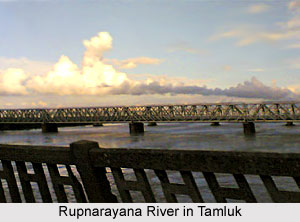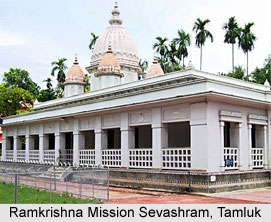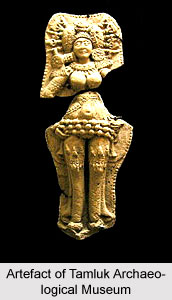 Tamluk is the site of the ancient city known as Tamralipta or Tamralipti, situated in Purba Medinipur district of West Bengal. The present town is located on the banks of the Rupnarayan River close to the Bay of Bengal. According to some scholars, the city`s name derived from the Sanskrit word, Tamra Lipta, which means "full of copper". The name must have been originated during the copper age, when Tamralipti was exported the ore and the metal to the peninsular India. According to local folklore the name Tamralipta came from the King Tamradhwaja (which means the king with Copper Flag/Symbol) of the Mayura-Dhwaja (Peacock) dynasty.
Tamluk is the site of the ancient city known as Tamralipta or Tamralipti, situated in Purba Medinipur district of West Bengal. The present town is located on the banks of the Rupnarayan River close to the Bay of Bengal. According to some scholars, the city`s name derived from the Sanskrit word, Tamra Lipta, which means "full of copper". The name must have been originated during the copper age, when Tamralipti was exported the ore and the metal to the peninsular India. According to local folklore the name Tamralipta came from the King Tamradhwaja (which means the king with Copper Flag/Symbol) of the Mayura-Dhwaja (Peacock) dynasty.
History of Tamluk
History tells us that the rivers have been central to urban settlement and development in the subcontinent from the ancient period. The Indus and the Ganges were cradles of ancient civilization. Tamluk was a civilisation based on Bay of Bengal and Rupnarayana River. The most important natural resource of this area was water from the rivers and sea. It was known as Tramralipti or Tamralipta in Mahabharata or Tamalitti in foreigners` descriptions or Tamluk in the British Raj. It was a seaport, now buried under river silt. For this reason, Tamluk houses many ponds and lakes today also. According to Jain sources, Tamralipti was the capital of the kingdom of Venga and was long known as a port.

Geography of Tamluk
Tamluk has an average elevation of seven meters. This ancient port city and kingdom is bounded by the Bay of Bengal in the south, River Rupnarayana in the east and Subarnarekha River in the west. The Rupnarayana is the joint flow of the Dwarkeshwar River and the Shilai River. The Bay of Bengal and these great rivers and their numerous branches created a prosperous and easy water navigational system fostering commerce, culture and early contacts with the people outside the region. At the same time, these rivers helped to develop the agriculture in this region.
Demography of Tamluk
As per the census of India, Tamluk has a population of 45,826. Males constitute 52 percent and females 48 percent of the population. 11 percent of the population is under 6 years of age. Tamluk has an average literacy rate of 77 percent, higher than the national average of 59.5 percent: male literacy is 83 percent whereas female literacy is 72 percent.
Culture of Tamluk
People of Tamluk are quite cultured. The place is always praised for its rich cultural activities. There are a number of arts schools, dance schools and theatre groups. There is also an important craft centre, located just 85 km south-west of Kolkata. Tamluk has always been well connected with the Gangetic Plains. In fact, there is evidence to suggest that the culture of Aryavarta influenced life in early Tamluk. The worship of Bheema is a sign of the socio-religious acceptance of Aryan culture in this area. Even in the recent past, Tamluk was divided into many areas based on caste and occupation, such as Malakar Para (flower traders), Adhikary Para (Brahmins), Dey Para (gold traders) and Mathore Para (sweeper`s colony). Tamluk celebrates a number of religious fairs and festivals including Charak Mela, Makar Sankranti Barunir Mela, Bhim Mela, Kali Mela and Ratha Yatra.
Government of Tamluk
The District Magistrate, who is one of the officers of Indian Administrative division, is the head of the Tamluk and its district Purba Midinipur. The Superintendent of Police, an officer belonging to the Indian Police Service, is responsible for maintaining law and order in the district.

Economy of Tamluk
Tamluk is mainly an agricultural area. About 60 percent of the land is under cultivation. Tamluk is one of the largest producer and exporter of betel leaves. Once fishing was also an important occupation of the local residents. Hilsa Fish (Ilish Mach) of the River Rupnarayan is very famous for its taste. Main crops of Tamluk are rice, bananas, coconut, potatoes, cotton, fresh vegetables and the agricultural products of the region are betel leaves and cashew nuts. Tamluk is also one of the highest "premium collecting area" of LIC in pan India basis.
Tourism in Tamluk
The bank of Rupnarayan River and green fields near the rail station are popular picnic spots in Tamluk. Tamluk Rajbari is located in the outskirts of town which once housed one of the many kings in West Bengal. There is also an Archaeological Museum in Tamluk which is a must see place of the town. Tamralipta Museum at Tamluk contains artefacts of `tamra` or copper. Inscribed copper templates comprise the documents of this museum. The museum has preserved a tamralipta of Greek inscriptions. The museum preserves the historical heritage of Bengal. Rakhit bati is another place to visit in Tamluk. In the beginning of 19th century it was famous as a secrete centre of the then revolutionary parties "Anusilan Samiti" and "Gupta Samiti".
Matangani Sahid Smarak, at the side of pond called Banpukur at Abasbari Para near Tamluk Court, is another place of tourist interest. During the "Ahimsa" movement of 1942, while a crowd was trying to capture Tamluk administrative building, British police open fired, in which Smt. Matangini Hazara was killed. Later on, Mahatma Gandhi appreciated her bravery and titled her as "Birangana". This monument was created to pay homage to her by the ex- prime-minister, Smt Indira Ghandhi.
Religious places of Tamluk include Barghobhima Mandir, Harir Mandir, Mahaprabhur Dalan, Jishnu-Hari Mandir Radhamadhav, Radharaman Mandir (at Rajbari) and Ramkrishna Mission Sevashram. Sanatan Shakti Peeth is another important pilgrimage site of Hindus and is one of the 51 sacred places of Shakti Peeth. The temple`s presiding deity is Shri Barghobhima Devi.



















